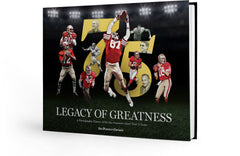Legacy of Greatness Individual Highlight: Bill Walsh
Excerpts and photos from the San Francisco Chronicle’s upcoming sports history book – Legacy of Greatness: A Photographic History of the San Francisco 49ers’ First 75 Years – provide some insight into one of the best head coaches in NFL history, William Ernest “Bill” Walsh.
"By 1978, the 49ers were a 2-14 team and completely irrelevant. They had that same dismal record in ’79, but there were two developments of massive significance. Joe Montana was drafted out of Notre Dame (with the last pick of the third round), and it was Bill Walsh’s first year as head coach.
As the practice sessions unfolded, a young defensive back was paying special attention. Tony Dungy, the NBC analyst and an NFL head coach from 1996-2008, was in the 49ers’ camp for his final season as a player. He was only 25, but already thinking about coaching after playing for the great Chuck Noll in Pittsburgh. Watching Walsh at work, Dungy said from his home in Tampa, sealed the deal. By the following season he was coaching the defensive backs at the University of Minnesota. 'I came from a Pittsburgh team that had just won the Super Bowl, and now I’m in San Francisco going 2-14,' Dungy said. 'But I got to see Coach Walsh build the foundation of a championship team almost from scratch. What really struck me was the confidence in his system. He wasn’t going to be swayed by anything negative. He didn’t have these wild (emotional) swings, like staging an extra two hours of practice because we lost. There was no doubt in his mind that his system was going to work, and that rubbed off on all the players.'
Rookie quarterbacks didn’t step right into the NFL starting lineups in those days, not even the real hotshots out of college. Playing behind Steve DeBerg, Joe Montana started only one game, a nondescript loss to St. Louis in Week 14. 'You could see the talent, the swagger, the confidence,' Dungy said. 'I don’t think anyone thought, ‘Best quarterback ever’ (laughs), but he did a lot of things that made you say, ‘Wow, this guy is special.’ That’s another thing about Walsh. He always looked at what guys could do well, and tried to maximize that. Even with Joe. Whatever Joe didn’t do great, that wasn’t in the game plan. That’s something I always remembered.' ...

Walsh and Montana confer during a preseason game against the Oakland Raiders on Aug. 12, 1979. JOHN STOREY / THE CHRONICLE
The genius of the Walsh-Montana connection became evident early on, in 1981, when the 49ers went 13-3, defeated Dallas on 'The Catch' in the NFC Championship Game and beat Cincinnati 26-21 in Super Bowl XVI. There were three more Super Bowl titles to come this decade, and the pillars of the San Francisco offense — Montana, Jerry Rice, Dwight Clark, Roger Craig, John Taylor, Freddie Solomon, Walsh’s playbook — got most of the credit. What often gets overlooked is the 1981 draft, when the 49ers drafted three defensive backs — Lott, Eric Wright and Carlton Williamson — to join Dwight Hicks in the secondary. On Jan. 17, 1982, the night the 49ers checked into their Pontiac, Mich., hotel, the players were surprised and delighted to find Walsh posing as a bellhop, wearing the proper garb and ready to tote their bags into the lobby. Seven years later, at the Airport Hilton in Miami, Eddie DeBartolo was the first person to greet them. Dressed as a doorman and disguised behind thick glasses, he opened a door for Walsh without the coach having the slightest idea who he was.
The 49ers put a zany set of bookends on those two Super Bowls against the Bengals. On Jan. 17, 1982, the night the 49ers checked into their Pontiac, Mich., hotel, the players were surprised and delighted to find Walsh posing as a bellhop, wearing the proper garb and ready to tote their bags into the lobby. Seven years later, at the Airport Hilton in Miami, Eddie DeBartolo was the first person to greet them. Dressed as a doorman and disguised behind thick glasses, he opened a door for Walsh without the coach having the slightest idea who he was.
By decade’s end, Kezar Stadium had been demolished, reconfigured into a 10,000-seat facility for soccer, track meets and high-school football games. That had to be a heartbreaker for George Seifert, who attended nearby Polytechnic High and served as a stadium usher in the late ’50s. But it was nothing to dwell upon. Seifert replaced Walsh for the 1989 season, inheriting one of the greatest teams of all time. The 49ers went 14-2 and demolished Denver 55-10 in Super Bowl XXIV. Over this magical period, they had somehow managed to turn Miami’s Dan Marino and the Broncos’ John Elway into ordinary-looking quarterbacks searching for answers. A more revealing statement is hardly imaginable."

Head coach Bill Walsh, San Francisco Mayor Art Agnos and 49ers owner Eddie DeBartolo proudly display the Super Bowl XXIII trophy along the parade route on Market Street in San Francisco on Jan. 23, 1989. BRANT WARD / THE CHRONICLE
This limited-edition book is the perfect holiday gift for your loved ones. Click the link below to purchase!

$39.95